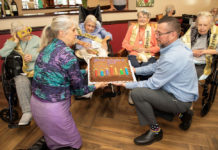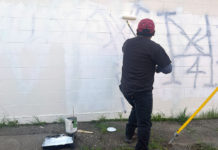As 2020 winds down, the Reveille will be taking time to reflect on the past year and everything that’s happened — from fires to a pandemic, Cloverdale has persevered. Despite barriers, the town came together for socially distanced or virtual events, supporting local businesses and more.
Over the coming two weeks, we’ll be sharing with you some of the highlights of the year.
In a March 5 article, the Reveille reported the first cases of COVID-19 in Sonoma County. On March 2, the Sonoma County Department of Health Services confirmed a presumptive positive case of COVID-19 in a resident who had traveled internationally. In response to the first county case, Sonoma County officials declared a local public health emergency, allowing the county to prepare for community spread of the virus.
“The county is very concerned, and I’m concerned,” said Fourth District Supervisor James Gore at the time of the article.
Also in the beginning of March, north county private K-8 school The Healdsburg School shut down following information that a parent had come into contact with a person who tested positive for the virus. The school reopened a day later following consultation with the county health department.
The county of Sonoma’s first health order went into effect on March 18. The order was expected to last through April 7.
Residents were instructed to shelter in their homes, except for leaving for essential activities and services such as grocery shopping. The order also directed all businesses and governmental agencies to cease all non-essential operations at physical locations in the county and prohibited all non-essential gatherings of any size and non-essential travel. Sonoma County Regional Parks and city parks also closed.
The order was issued in response to the six cases of COVID-19 that the county had at the time, and the 258 confirmed cases and three deaths in the seven Bay Area jurisdictions that had occurred at the time.
In Cloverdale, the city declared a local state of emergency on March 15.
While the earlier and current health orders mean that local senior centers can’t be open, the Cloverdale Senior Multipurpose Center has stepped up as a resource hub since the beginning of the pandemic. In March, the Reveille reported that the senior center started a volunteer initiative where Cloverdale residents could sign up to volunteer and pick up and drop off groceries and medications to seniors.
“We are very concerned about our seniors being isolated,” said center program director Melanie Hall in March. “We worry about our seniors in general being isolated and how that leads to depression and decline in overall health, and so we’ve learned some lessons from the Kincade Fire and the power outages that we want to improve on as a community.”
Later in the year, the center began offering virtual classes, community city council debriefs and regular food distribution for both senior center members and community members who don’t belong to the center.
On March 31, Sonoma County Health Officer Dr. Sundari Mase announced that the county shelter-in-place order would be extended until May 3.
In early April, Mase reported that modeling data from the Imperial College of London revealed that the county’s shelter-in-place order was significantly flattening the curve of COVID-19, and reducing the mortality rate for those over the age of 65.
In the middle of April, local women took to their vehicles to drive through downtown Cloverdale once a week, honking their cars as a way of showing appreciation for essential workers. Pre-pandemic, the group met for Friday night dinner every week, but they decided to wear funky hats and drive down the boulevard as a way of doing something together while expressing appreciation for others.
Toward the end of April Sonoma County parks reopened again, however, the hitch was you could only visit a park by getting there on foot or by bicycle.
As the shelter-in-place order and pandemic wore on into June, Sonoma County Sheriff Mark Essick made a controversial announcement that effective June 1 he would direct all sheriff’s office staff to discontinue the enforcement of Sonoma County Public Health Orders issued by the Sonoma County Public Health Department and the Public Health Officer.
On June 2 the county released a joint statement with the sheriff’s office in which both parties agreed to play nice.
Starting June 6, in-person faith-based services, indoor retail shopping and dining, hair salons and barbershops were allowed to reopen in Sonoma County with mitigation measures in place such as facial coverings and social distancing.
The updated order also permitted the reopening of public, semi-private and private pools in health clubs. Mase had said health clubs could provide facilities for lap swimming and fitness classes when following certain provisions such as six-foot social distancing.
One question that was still up in the air was when people could go to hotels, rent short-term vacation homes, or go on vacation and leave town. At the time, the answer was “Not yet.”
Sonoma County was added to Gov. Gavin Newsom’s coronavirus county watchlist on July 10, joining 29 other counties in the state. The watchlist placement was in response to an uptick in COVID-19 cases seen in June and early July.
According to The Reveille’s reporting, “Virus cases in the county over a 24-hour period spiked on July 3, when the reported new cases in a single day nearly doubled the previous highest spike. Initial numbers reported listed 92 new cases on July 3, though the county’s coronavirus data portal says that 87 new cases were added.”
Following the announcement of the county’s placement on the state coronavirus watchlist, Newsom announced in a July 13 press conference that all California counties would be required to close dine-in restaurants, indoor operations for wineries and tasting rooms, movie theaters, family entertainment centers, zoos and museums and cardrooms. Bars, brewpubs, breweries and pubs were also ordered to halt all operation (outdoor included).
Since the county was on the state’s watchlist, fitness centers, worship services, protests, offices for non-essential sectors, personal care services (like nail salons, body waxing and tattoo parlors), hair salons and barbershops and malls were also required to shut down or not happen, unless they can be moved outdoors or operate via pick-up.
Before the announcement, Sonoma County was on its first day of the closure of dine-in restaurants, indoor operations for wineries and tasting rooms, movie theaters, family entertainment centers, zoos and museums and cardrooms, due to the earlier closure guidelines related to being on the state’s watchlist.
Toward the end of August another major COVID-related change was announced. Newsom and the California State Department of Public Health announced a new state COVID-19 monitoring system for counties that involves four color-coded tiers related to coronavirus spread.
The tiered system, Blueprint for a Safer Economy, dictates how specific business sectors can operate. In the purple tier many non-essential indoor business operations are closed. The red tier denotes that some non-essential indoor operations are closed.
The orange and yellow tiers are a bit looser in terms of which business sectors can be opened indoor or out.
For school districts, the monitoring system addresses when and how schools will be allowed to open for in-person learning. Counties like Sonoma County that are in the purple tier — the most severe tier that denotes a widespread presence of coronavirus — cannot be open for in-person learning and must stay in distance learning.
Once a county moves from purple into the red tier and has been in the tier for at least weeks then school districts, private and charter schools can move to some form of in-person learning, whether it be hybrid learning or full-time in-person learning.
In early October the coronavirus came to the Healdsburg District Hospital.
Contact tracing and the testing of 287 Healdsburg District Hospital health care employees in the later weeks of October confirmed that the hospital had a total of 14 positive COVID-19 cases during the period of Sept. 27 to Oct. 28.
Findings confirmed that at least one of the recent cases was contracted between colleagues who work closely together and socialize on breaks.
No cases of transmission to patients were found, according to a hospital press release from Healdsburg District Hospital spokeswoman Gina Fabiano.
In October, regular virus testing came to Cloverdale, with pop-up testing happening in the Plaza every Thursday from 9 to 11 a.m.
In November as cases began to rise throughout the country, state and the county, Newsom announced new restrictions including a curfew for counties that are in the purple tier.
In December a new state stay at home order was introduced following an explosion of increased cases resulting from holiday gatherings from Halloween and Thanksgiving festivities.
In a statement on Dec. 10, the county announced that due to rising COVID-19 case numbers and hospitalizations, the county would join six other Bay Area counties and the city of Berkeley in preemptively adopting the California Department of Public Health’s Stay-Home Order beginning at 12:01 a.m. on Saturday, Dec. 12 and lasting through at lease Jan. 9, 2021.
The order was similar to the March order but did allow retail business to remain open at 20% capacity.
Under the order residents are directed to stay at home except for work, shopping or other essential activities, such as medical appointments. All sectors other than retail and essential operations must be closed. Outdoor recreation, like hiking, biking and skiing, will be allowed. While many have called December the darkest hour of the pandemic, a sliver of light and hope started shining with the release of the Pfizer vaccine.
In a virtual conference on Dec. 14, Mase announced that the first doses of COVID-19 vaccine would be arriving in Sonoma County that week.
The five boxes of the Pfizer vaccine arrived on Dec. 16, each box containing 975 doses. One box each was delivered to Kaiser Hospital, Sutter Hospital and Memorial Hospital, with the final two boxes being kept by the county’s health department. The larger hospitals will distribute the vaccine to the smaller hospitals: Healdsburg District Hospital, Sonoma Valley Hospital and Petaluma Valley Hospital.
38.9
F
Healdsburg
March 18, 2025








